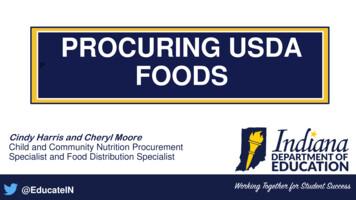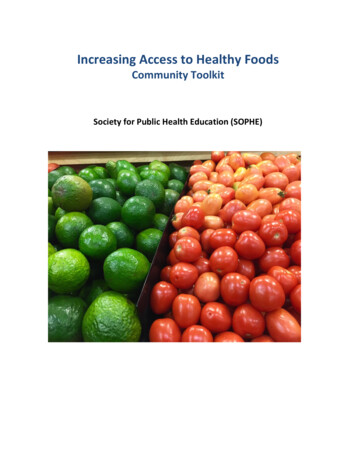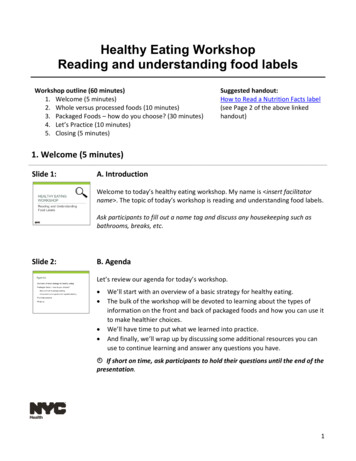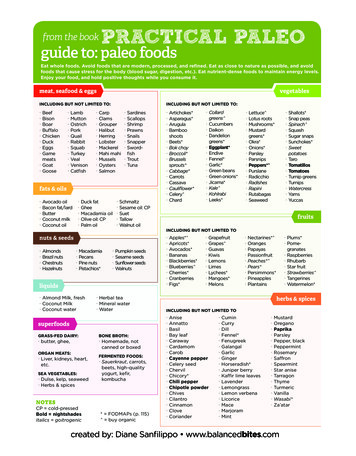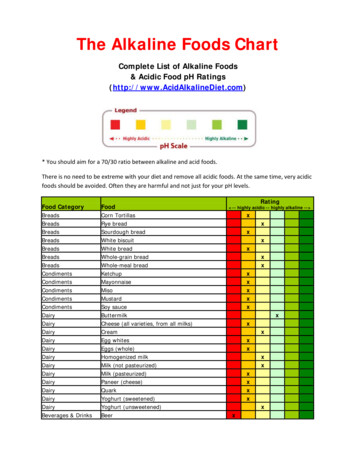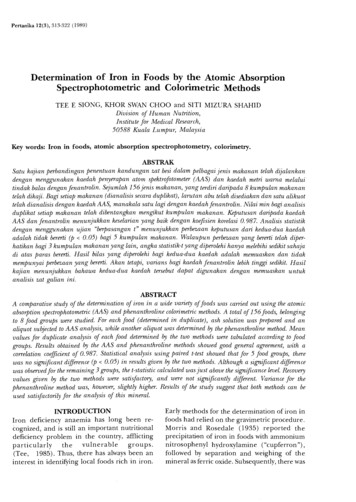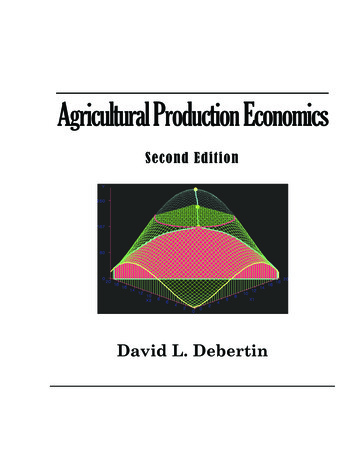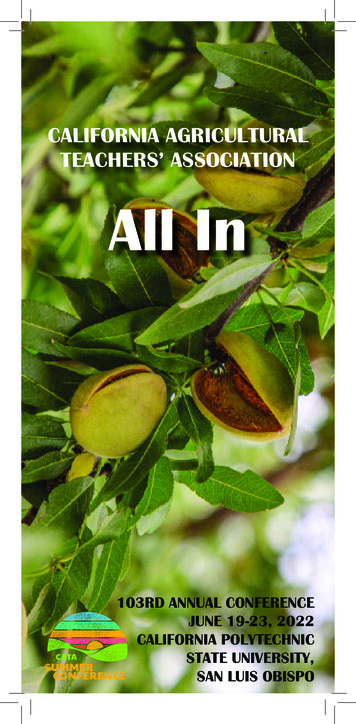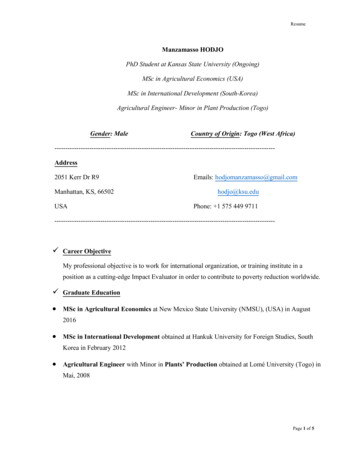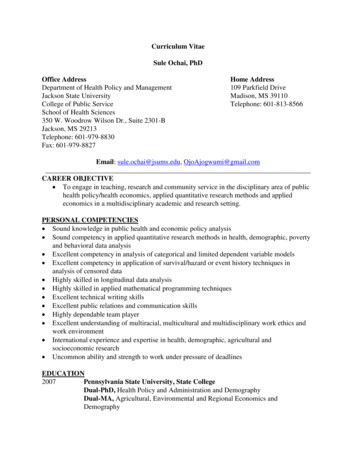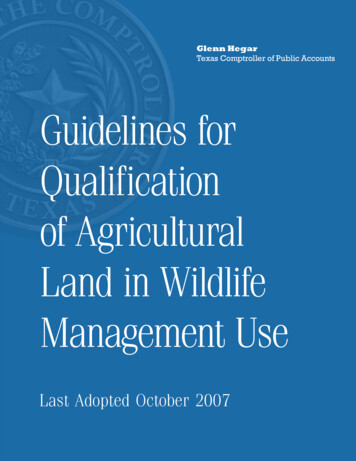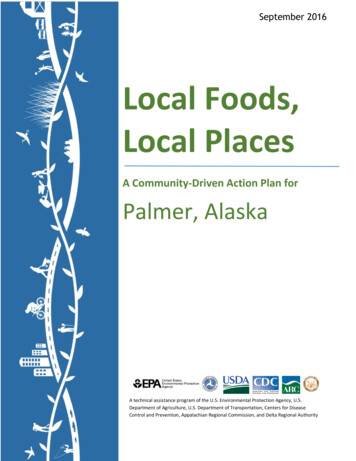
Transcription
September 2016Local Foods,Local PlacesA Community-Driven Action Plan forPalmer, AlaskaA technical assistance program of the U.S. Environmental Protection Agency, U.S.Department of Agriculture, U.S. Department of Transportation, Centers for DiseaseControl and Prevention, Appalachian Regional Commission, and Delta Regional Authority
Local Foods, Local Places Action Plan – Palmer, AlaskaLocal Foods, Local Places: PalmerCommunity StoryPalmer is a community of approximately 7,000 people within the Matanuska-Susitna (“MatSu”) Borough of Alaska. Located less than an hour northeast from Anchorage, Palmer and theMat-Su Valley are the most productive agricultural areas of Alaska, producing what isestimated to be 32 million per year of commercial agricultural product. With a short butintense growing season, the Mat-Su area is famed for enormous vegetables such as hugecabbages, pumpkins, and zucchini. These vegetables are displayed annually at the AlaskaState Fair held in Palmer and have won several state and world records. The soil compositionand cool nights make carrots that are up to eight times sweeter than those grown elsewhere.Grow Palmer has established edible garden beds and planters throughout downtown. 1Palmer’s history is agricultural, established in the 1930s by the U.S. government as a Colony.Original Colony families were recruited from the Midwest of the continental U.S. to comehomestead and farm the rich soils. The Class 2 soils in the valley can be as deep as 10 feet,owing to the confluence of water and glacial systems that has made this valley exceptionallyfertile. It is also an area rich in wild local food resources including berries, moose and other1Note: Credit for all photos goes to Erica Heller, Progressive Urban Management Associates, and Chris Freda, Sasaki.1
Local Foods, Local Places Action Plan – Palmer, Alaskagame, and birch sap (which is made into syrup). Many locals also participate in wild harvestof many kinds of fish both in and beyond the Mat-Su Valley.Prominent commercial crops in the Mat-Su include potatoes, carrots, broccoli, cabbage andonions. Root crops, which travel and keep relatively well, are available in Alaska yearround. In season, many other vegetables are grown for the Alaska market including lettuces,zucchini, swiss chard, spinach, potatoes, kohlrabi, herbs, beets, fennel, raspberries andapples. Some farmers also grow tomatoes, basil, and other warmer weather vegetables inhoop houses. Other local farmed products include eggs, beef, lamb, pork, bison, elk, barley,wheat and dairy.Grow Palmer created this 2016 Edible Harvest self-guided map.2
Local Foods, Local Places Action Plan – Palmer, AlaskaAssetsPalmer has a number of assets to build on for advancing placemaking, economy, andaccessibility of local foods. Palmer has two weekly markets: The Monday Market and theFriday Fling. The Monday Market is primarily focused on food, while the Friday Fling hasmore of a craft, music, and entertainment focus, but does include some food vendors.Several of the Valley growers offer weekly farm stand hours where they sell to the localcommunity, and many sell direct to local restaurant buyers at the farm.Some of the downtown Palmer restaurants and vendors source foods locally and incorporatethem in the menu, such as Turkey Red and The Palmer Alehouse. Some of them began doingthis under a Restaurant Rewards state incentive program, and have continued to do so evensince the funding for this program ceased. Generally, the restaurants may display a plaquein the lobby indicating they do some local sourcing, but do not indicate by menu item whichfoods are sourced locally. There are many reasons for this, including that while they maysource locally during the growing season, they also use non-local foods for the same itemsduring the balance of the year.Grow Palmer has established edible garden beds and planters throughout downtown.Grow Palmer is a local organization that has established garden beds and plantersthroughout downtown and filled them each year with edible plants that are free for anyoneto harvest. This includes planters and other public garden beds. Most recently, Grow Palmercompleted the first phase of an edible rail trail, placing 40 planters along the end of aregional bike trail that parallels an old rail bed. The project connects local food to active3
Local Foods, Local Places Action Plan – Palmer, Alaskaliving. Funding has been secured to double its size, which will be completed in 2017. Thetrail ends at the Palmer Depot, a community center where the Monday Market is hosted.Historical and agricultural signage contributes to Palmer’s tourism.Palmer has agritourism assets. Within downtown are interpretive plaques telling the historyof the Original Colony. The Alaska State Fairground is located in Palmer and is widely citedin visitor materials as a reason to visit the Mat-Su Valley. Occurring for twelve days per yearin late August through Labor Day weekend in September, it attracts people from all overAlaska as well as out-of-state visitors. Year-round, the Palmer Visitors Center highlights theproductivity of the valley, with public art showing the astounding size of some of theprizewinning vegetables, and during the summer months, a demonstration garden. Visitorscan self-drive through the beautiful countryside and see the rows of vegetables growing.There are no farms that host visitors on a daily or drop-in basis, but in 2016, a local Palmerresident began a business called Alaska Farm Tours that has begun to offer tours to farms inthe Valley.ChallengesAlthough a wide range of crops are grown in Mat-Su Valley, even in summer most of theproduce that is readily available to residents is imported. Although two of the three localgrocers regularly carry local milk, carrots, potatoes, lettuce, and kale, they carry few of theother products. There are a number of challenges that make this so. For one, the grocerslook for steady, reliable, sources for each product such as their consolidated distributors.4
Local Foods, Local Places Action Plan – Palmer, AlaskaWith a short growing and harvest season for each local product, many local products – suchas zucchini – are only harvested locally for a few weeks per year. Grocers do not typicallyswitch their buying pattern for that short term.In addition, many of the products grown locally are grown on a small scale, and thus are onlyavailable at farmers markets and farm stands or through pre-paid shares. Many localresidents are not aware of where and when these venues are open or what products areavailable at them on a particular day, and do not regularly patronize the local venues. Also,local producers find it more profitable to take market goods to farmers markets inAnchorage, where the greater number of patrons increases sales per hour/day compared toPalmer venues. Locals state that the Palmer Monday Market, which features local foods, isnot very visible or well attended. This discourages local producers from making theinvestment of time and resources in participating.Finally, many small-scale producers are at maximum capacity, and there are a limitednumber of small-scale farms. While the production farms are shipping significant quantitiesof the main crops throughout the state, there is still not enough market produce beinggrown for local, Alaskan consumption. They would need evidence of demand in Palmer atprices equal or better to what other customers will pay in order to keep more of the productlocal, or to produce more than current levels. Additional infrastructure, such as coldstorage, could potentially alleviate some of the risk of over-production, as farmers take on asubstantial financial risk producing for an unpredictable market.There are significant barriers to starting up more small-scale farms in the Mat-Su Valley.Some of the most fertile agricultural lands are being converted to subdivisions as growth inAnchorage pushes more residents to Palmer, and some aging farmers are seeking to “cashout” of farming through land sales. Designated Mat-Su Borough agricultural land sales are aminimum of 40 acres, more than most new farmers can afford. Identifying and addressingthese barriers will be key to growing a small-scale farm community in the Mat-Su Borough.While there are local restaurants in Palmer that source foods locally, some of them need theproduce prepared due to preference, labor availability, and space constraints. For example,local restaurateurs report they lack the space to wash and chop lettuce, preferring to haveit delivered pre-prepared. Local producers state they also lack the labor or desire to beinvolved in the food preparation business, preferring to sell lettuce to wholesalers and5
Local Foods, Local Places Action Plan – Palmer, Alaskaretailers of whole product, rather than take up the processing, which comes with food safetyrequirements and regulations.There is a desire to grow awareness and make Palmer a destination for local foods. Palmer iswell known in Alaska as a farming region, but is not necessarily understood as a place to gosample and enjoy local food. Local restaurants do not prominently display the use of localfoods in their marketing or menus, and are not included in statewide dining guides. The areaand its history is not especially well known outside of Alaska. Despite the fact that datashows agritourism as a growing area in the travel industry, Alaska visitor materials makelittle mention of agritourism opportunities in Palmer other than the State Fair, whichhappens only twelve days per year.Better connections are needed between producers, retailers, and restaurants.6
Local Foods, Local Places Action Plan – Palmer, AlaskaIn Downtown Palmer, connections among local foods assets and between local foods andother healthy living assets could be improved. Palmer has limited public transportation.Missing sidewalk segments, crosswalks, and a disconnect between the biking and walkingtrails and downtown hinder easy movement between residential areas, schools andbusinesses.Project AssistanceIn 2015, Grow Palmer, a local group organized to provide public food gardens in Palmerrequested assistance through the Local Foods, Local Places program to develop an actionplan for achieving its vision. The program is supported by the U.S. Environmental ProtectionAgency (EPA), U.S. Department of Agriculture (USDA), U.S. Department of Transportation(DOT), the Centers for Disease Control and Prevention (CDC), the Appalachian RegionalCommission (ARC), and the Delta Regional Authority (DRA). Implementing the actionsdescribed later in this plan can bring several benefits to the community including: More economic opportunities for local farmers and business. Better access to healthy, local food, especially among disadvantaged groups. A revitalized downtown that is the economic anchor of the community.Figure 3. The diagram above lays out all of the steps leading to this action plan.7
Local Foods, Local Places Action Plan – Palmer, AlaskaEngagementLeading up to the workshop, a local steering committee and federal partners convened threetimes by conference call and webinar to discuss the community’s goals and plan the event.The local steering committee was comprised of the following participants: Chair: Jan Newman, Grow PalmerAmy Pettit, Alaska Farmland TrustFrankie Barker, Mat-Su BoroughChantel Welch, NeighborWorks AlaskaTerry Snyder, Alaska AARPNate Wallace, Palmer City ManagerThe main sessions of the Local Foods, Local Places workshop were held over two days in thePalmer Depot in Downtown Palmer on July 26 and 27, 2016. Prior to the workshop’s firstpublic session, the technical advisory team, local steering committee, and federal partnersparticipated in an informal lunch.Nearly five dozen people attended the workshop, with many participating both days. Allsessions were open to the public. See Appendix A: Workshop Participants for details onattendees. A compilation of photos from the workshop and tour can be found in Appendix B:Workshop Photo Album. A link and visual representation of results of the asset mapping exerciseare found in Appendix C: My Community Asset Mapping.The first day began with a walking and van tour of food-related sites in Palmer, starting witha visit to the VanderWeele’s farm. Patriarch Ben and his daughter Michelle Keyes sharedwith participants their experience as large-scale commercial growers who supply both localgrocers and wholesalers with production items such as potatoes, carrots, and lettuce, aswell as specialty foods for farmers markets, and a small number of other local restaurants.The group also viewed the State fairgrounds and several agricultural tracts protected by theAlaska Farmland Trust. Next, Jan Newman lead the group on a tour of Downtown food andhealthy living assets including the rail trail edible gardens, placards that provide tribute tothe original Colony families, the visitors center gardens and artworks commemorating thestrength of Mat-Su agriculture, and several local restaurants offering local foods. She alsopointed out deficiencies in walking and biking links between the downtown assets, such asdisconnected sidewalks, trails, crosswalks, and a bike trail that terminates at the Palmer8
Local Foods, Local Places Action Plan – Palmer, AlaskaDepot. After a lunch at Turkey Red Café featuring local foods, the participants toured ArcticOrganics, a small family-owned farm that direct markets its produce through communitysupported agriculture (CSA) shares, farmers markets, and individual contracts with localvendors.The workshop began in the afternoon with a welcome and commitment of support by thePalmer Mayor. In the initial session, participants were introduced to the program and thebackground leading up to the workshop. Exercises were then conducted to work throughvalues, visioning, and tying vision to place. After the general session, a producers andvendors special session was held to get ideas and views from local producers. Attendeesrepresenting market farms, animal and egg processors, as well as representatives of theAlaska Farmland Trust, State Division of Agriculture and Mat-Su Borough were there.Attendees noted that wild harvested products, which are traditional in Alaska should also beconsidered in thinking about local foods.On the second day, the workshop continued with exercises to learn about potential actionsand mapping tools, brainstorm actions and select priorities, and develop specific actionsteps. The group completed actions in five goal areas to form the basis of the Action Plan.See Appendix D: Workshop Exercises for more details on the exercises. Appendix E: FundingResources and Appendix F: Additional Resources are also included as comprehensive listingsof federal, state, private, and local resources.Two news articles were published locally, one leading up to the event and one reporting onit afterwards, and can be found in Appendix G: Press Coverage.VisionThe community’s vision encompasses many elements. Among these is to be a place where allresidents have access to local food and awareness about its availability. The community alsostrives to leverage its agricultural identity to become a local foods destination. Thecommunity also envisions a region that protects farmland and expands the production,particularly of local market foods.9
Local Foods, Local Places Action Plan – Palmer, AlaskaOpportunities and ChallengesThroughout Day One, participants had engaging conversations about their perceptions ofopportunities/assets, and challenges in Palmer, as they relate to local foods goals.Opportunities/Assets Known for agriculture within AlaskaRich Class 2 soils - 10’ deep topsoilExisting community-serving producersRail trail and community edible “u-pick” gardensExisting supply chain for 2 of 3 local grocers30 year Alaska Grown programFarmers market SNAP grant dollarsStartup small local distributorExisting farm stands and farmers marketMat-Su Borough agricultural land salesExperimental farm structures and coolersAK Farmland Trust preservation toolsFarm-to-School programChallenges Lack of awareness about local foods availabilityUncertainty, inconsistency in growing conditionsShort season/limited year-round productionSubdivisions built/platted on prime agricultural landsLarge scale distributors discourage local buyingFarmers and small vendors have limited time/staff/motivation for distributionLimited quantity of market vegetablesCost of local products is higherAnchorage farmers markets are more profitable; inconsistent food regulationsTimely information about availabilityLack of local policies/goals to promote10
Local Foods, Local Places Action Plan – Palmer, AlaskaAction PlanThe following five overarching goals and action items were finalized at the workshop withinput from all participants. A detailed description of the goals and actions items can befound in the implementation matrices, below.Goal 1: Support local growers & vendors, and processors. Action 1.1 Establish a Mat-Su/Palmer Local Food Policy Council Action 1.2 Promote the education of local/seasonal eating and food preparation Action 1.3 Make the Monday Market stronger and more visible Action 1.4 Replicate Kenai Food Hub model in Palmer Action 1.5 Establish a commercial kitchen production and processing space for smalllocal producersGoal 2: Promote farmland and wild food resources stewardship and preservation. Action 2.1 Gather data on farmland to create the case for agricultural preservation,mitigation, and agricultural subdivisions. Action 2.2 Showcase Mat-Su farmlands on wayfinding and visitor maps Action 2.4 Create an Agricultural Lands Mitigation Bank Action 2.4 Create an Agricultural Special Use designation and identify areas to include(potentially) Agricultural SubdivisionsGoal 3: Improve local food accessibility and food security by increasing availability of Mat-SuValley food to local residents Action 3.1 Research and identify a model for the “Kitchen Garden Project” andestablish regular stakeholder meetings Action 3.2 Survey local producers to identify quantity and makeup of surplus crops ona weekly basis Action 3.3 Improve real time information system for what local food is available Action 3.4 Compile a report to identify the needs of local institutions, local supply,and actual/perceived barriers to introduce local foods to institutionsGoal 4: Build on agricultural identity to become a local foods destination. Action 4.1 Year-round showcase market for local foods Action 4.2 Local foods wayfinding and placemaking through maps, signage, apps, anddecals Action 4.4 Fund a position at an existing nonprofit to coordinate work11
Local Foods, Local Places Action Plan – Palmer, Alaska Action 4.5 Agree on the brand for Palmer local foodGoal 5: Increase collaboration and integration with efforts for a healthy, vibrant, walkablecommunity. Action 5.1 Edible Rail Trail Phase II Action 5.2 Improve Downtown walkability and bikeability Action 5.3 Improve crosswalk and sidewalk segmentsImplementation MatricesImplementation matrices, which include specific details for each action to aid inimplementation, are found below.Time Frame Key:Short 0-6 monthsMedium 6-12 monthsLong 1-2 yearsGoal 1: Support local growers & vendors, and processorsActionWhy is thisactionimportant?1.1 Establish aMat-Su/PalmerLocal Food PolicyCouncil1.2 Promoteeducation of localand seasonaleating and foodpreparation1.3 Make theMonday Marketstronger andmore visible Advocate for small Address disconnect Consolidate a producers’ needsbetweenmarket that Create a unifiedconsumers andfocuses on foodvoice for localgrowers Create a single, agricultural Better identifywell-known visibleconcerns to speaklocal foodsfood focusedto Alaska agencies Utilize availablemarket local foodHow will we Formation ofcommitted LFLPmeasuregroupsuccess? Sales of local foods Number ofat local venuesparticipating(restaurants,vendorsmarkets, etc.) Number ofconsumers Sales figures121.4 Replicatethe Kenai FoodHub model inPalmer1.5 Commercialkitchen productionand processingspace for smalllocal producersCoordinatessupply anddemandStrengthensmarket forgrowersEase of access Encourage moresmall businessgrowth based onlocal foods Increase year-roundavailability Utilize existingresources Existence of a Hours of use offunctional food hub commercial Number ofkitchens byparticipatingsecondary usersgrowers andconsumers
Local Foods, Local Places Action Plan – Palmer, AlaskaTime FrameShortShort: advocateShort: signageLong: implement inSpring 2018 seasonMediumLead RoleLocal Food PolicyCouncilLocal Food PolicyCouncilMonday MarketmanagersAlaska PacificUniversity’sSpring Creek FarmLocal Food PolicyCouncilPotentialSupportingCast Alaska Food PolicyCouncil Ag Commission Alaska FarmlandTrust Alaska FoodCoalition ARRC Mat-Su Health Alaska PacificUniversity AARP NeighborWorks Now Health Mat-Su HealthFoundation Restaurants, esp.Turkey Red SNAP Educators Alaska PacificUniversity ARRC AmeriCorps Vista Health/Exercise,Active businesses Chef At The Market Friday Fling Richelle Plumber Growers Grow Palmer DowntownMerchantsAssociation PEDA Chamber ofCommerce Growers,Customers University ofAlaska Fairbanks City of Palmer NeighborWorks Cook Inletkeeper Arctic Harvest Department ofCommerce Owners ofcommercialkitchens Chamber ofCommerce Local Food PolicyCouncil School District Producers SNAP programsand educationalmaterials Marketingmaterials Signage Newsletter ads andpress releases Recreate Chef AtThe Market Meet Me At TheMarket Platform An outreach 80/monthcampaign to Part time staffidentify potential Distribution spaceusers Staff time A system (an appor other) to matchavailable spacewith users USDA Experimental Palmer Chamberfarmand US Chamber of Bogard LogisticsCommerce AmeriCorps or Vendor feesstudents Sponsors e.g.Lions Club ARRC Alaska Grown USDA grants Mat-Su HealthFoundation AARPWhat will itcost, whatwill it take? Volunteercoordinators Monthly meetings USDAPossible Local foundations,sources,contributions e.g. Mat-Su Healthetc.Medium to Long:Make available Create, Compileand distributeeducationalmaterials Educators conduct1 on 1 meeting Press release Coordinate withBrandingMedium: marketand build13 USDA Local foundations,e.g. Mat-Su Health
Local Foods, Local Places Action Plan – Palmer, AlaskaGoal 2: Promote farmland and wild food resources stewardship and preservationAction2.1 Gather data on2.2 Showcase Mat-Sufarmland to create thefarmlands oncase for agricultural wayfinding and visitorpreservation,mapsmitigation, andagriculturalsubdivisionsWhy is thisactionimportant? To tell the story To convince residentsto preserve ag landsHow will wemeasuresuccess? Resident awareness Information use If the data is used toset policyTime FrameLead RolePotentialSupportingCastWhat will itcost/take?2.3 Create anAgricultural LandsMitigation Bank2.4 Create anAgriculture SpecialUse designation andidentify areas toinclude (potentially)AgriculturalSubdivisions Supports farmland Funds the protectionpreservation effortsof additional acreage Encourages interest in Creates perception ofvalueFarm Tours and otherAgricultural tourism ShortMediumLongLong University of Alaska Institute of Social andEconomic Research Mat-Su Borough The NatureConservancy Alaska Farmland Trust USDA Visitors Center Farm Tours Grow Palmer Ag Advisory Council American FarmlandTrust Great Land Trust Land Trust AllianceMat-Su 2050 andAlaska Farmland Trust 50,000 for data Unknown cost forstorytelling Alaska FarmlandPossibleTrustsources, USDAcontributions Mat-Su Healthetc. Creation & distribution Amount of fundingof mapsreceived Acres protectedMat-Su Borough, andNew Local Food position(Action 4.3) Mapping PrintingAlaska FarmlandTrust Public educationcampaign Alaska Farmland Trust A special event or USDAfundraiserFoundation14Legacy planningFood securityKnowledge retentionProtecting mostvaluable lands Number of acresdesignated Percent of farmlanddesignatedLocal CommunityCouncils Ag Advisory CouncilAlaska Farmland TrustMat Su BoroughDevelopersCities Public educationcampaign Focus groups Rasmuson Foundation Cook Inlet Tribal NeighborWorks
Local Foods, Local Places Action Plan – Palmer, AlaskaGoal 3: Improve local food accessibility and food security by increasing availability ofMat-Su Valley food to local residents.ActionWhy is thisactionimportant?How will wemeasuresuccess?Time Frame3.1 Research andIdentify a model for“Kitchen GardenProject” and establishregular stakeholdermeetings3.2 Survey localproducers toidentify quantityand makeup ofsurplus crops on aweekly basis3.4 Compile a report toidentify needs of localinstitutions, localsupply, andactual/perceivedbarriers to introducelocal foods toinstitutions Combines Alaska Tilth, First step in Demonstrate and First step in buildingYarducopia, andunderstanding surplusincrease demand formutual understandinggardening supportand how it can be usedlocal growers’ products of existing andgoals Opens channels of Reduce wastepotentialcommunication Stronger local economy opportunities A model is identified Catalog of surplusfor the frameworkproduce that can be At least one conveningsalvagedShortMediumChantel Welch,NeighborWorks AlaskaDivision ofAgriculturePotentialSupportingCast What will itcost, whatwill it take? Time and commitment Time App or electronicsystemLead Role3.3 Improve realtime informationsystem for whatlocal food isavailableSpring Creek FarmYarducopiaCESMaster GardenersAlaska Cold ClimatePermaculture Institute New Local Foods GroupChurchesAlaska Farmland TrustAPU studentMat-Su College NeighborWorks and Mat-Su HealthPossibleLocal Food Group (staffFoundationsources,time) Alaska Conservationcontributionsetc.15 Number and specificity Report is successfullyof listings in local foodcompletedinformation systemLongLongNew Local FoodUniversity of Alaska position (see Action 4.3) Public Health, andInstitute of Social andEconomic Research(ISER) - Steve Colt Grow Palmer Spring Creek FarmFood Policy Council Division of AgricultureAlaska Farmland Trustand Mat-Su BoroughGrowersput in joint request toMonday MarketISERLocal Businesses SPORK ConsultingAARP Staff time Improved bulletinboard An app or similar University support USDA EPA Mat-Su HealthFoundation AK CommunityFoundation Time Student, intern,volunteer Staff time Division of Agriculture- Farm to Institution
Local Foods, Local Places Action Plan – Palmer, AlaskaGoal 4: Build on agricultural identity to become a local foods destination.ActionWhy is thisactionimportant?How will wemeasuresuccess?Time FrameLead RolePotentialSupportingCastWhat will itcost, whatwill it take?4.1 Year-roundshowcase market forlocal foods4.2 Local foodsWayfinding &placemaking throughmaps, signage, apps &decals4.3 Fund a position atan existing nonprofitto coordinate work4.4 Agree on thebrand for Palmerlocal food Entertainment Lets people know Educationwhat is available Community Building Can promote what is Improve local food sales important to the town Identifies areas foropportunity Creates a means toapply for grants andfunding opportunities Ensures coordinationbetween efforts Branding helps peopleremember the produceand place Associate name with alocationShort: planningMedium: Wayfindingdesign planLongLongCity of Palmer, and,Dept. of AgricultureJan Newman, GrowPalmer Study Printing Marketing Physical signage Staff time & effort toapply for grants or anintern Number of attendees(helps justify a largerpermanent space) Amount of salesMedium: start activitiesin Spring of 2017Monday MarketCoordinator Creation of maps,signage, apps, anddecalsMedium-to Long:Implementation ProStart - High School Chamber of Commerce Grow Palmer Local organizations to Alaska Public Mediaimplement and provide Librarydata Division of Agriculture Farm to School Job Corp - food demos Career Tech Coordination Pay stipends to chefs,musicians, and teachers Food and supplies Sponsorships Chamber of CommercePossible Visitors Centersources,contributions USDA FMPPetc. City of Palmer - 35Kavailable USDA RuralDevelopment Chamber of Commerce Visitors Center16 Nonprofit identified Funding and grantsreceived Local Food PolicyCouncil AK Farm Trust NeighborWorks Local Foods LocalPlaces attendees SNAP ED USDA Mat-Su HealthFoundation EPA AmeriCorps VISTA Number of searches Number Facebook likes Increased local foodsalesLocal Food PolicyGroup New local food position Local Businesses USDA RuralDevelopment AARP Mat-Su Borough City of Palmer Grow Palmer logo Citizen input to agreeon brand Design work Printing, production Distribution City of Palmer Local Businesses USDA RuralDevelopment Grow Palmer
Local Foods, Local Places Action Plan – Palmer, AlaskaGoal 5: Increase collaboration and integration with efforts for a healthy, vibrant,walkable community.5.1 Edible Rail Trail Phase II5.2. Improve Downtownwalkability and bikeability5.3 Improve crosswalk andsidewalk segmentsdowntownWhy is thisactionimportant? Accessible fresh food anytime! Agricultural identityHow will wemeasuresuccess? Random harvesting happening Safety and accessibility Economic vitality Growing senior population Transportation options yearround, all ages Safety and accessibility Economic vitality Growing senior population Transportation options yearround, all agesTime FrameShort: construction by the end of2016Action Downtown walkability audit Traffic accident data Bikeability study Maps/app Construction and painting,downtown Walking Map/app, and signage Walk ScoreLead RoleGrow PalmerMat-Su BoroughPotentialSupportingCast City of Palmer, fiscal sponsor,water and power SDG Sustainable Design Gro
Local Foods, Local Places Action Plan - Palmer, Alaska. 3 . Assets . Palmer has a number of assets to build on for advancing placemaking, economy, and accessibility of local foods. Palmer has two weekly markets: The Monday Market and the Friday Fling. The Monday Market is primarily focused on food, while the Friday Fling has
